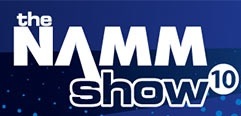In some ways, the 2010 Winter NAMM show was a different show, but the larger vendors were not missed nearly as much as one might imagine. Attendance was actually up, according to the NAMM press office, and anyone who was there will attest to the fact that the floor was jammed every single day of the show.
The bonus was that the less corporate vendors and manufacturers really shined with some excellent new products in many cases. While some companies did not present anything really new, there were some very impressive items that caught the attention of the attendees.
Why did we wait so long to release our “Best of Show” Macsimum Awards? We wanted to try many of these products off the show floor and away from the noisy environment that can make it tough to know what you are really listening to when sound quality really counts. So, without any further ado, the 2010 Winter NAMM “Best of Show” Macsimum Awards.
Sony PCM-M10 Portable Digital Recorder (http://pro.sony.com/bbsc/ssr/cat-audio/cat-recorders/product-PCMM10/B/)
This super-small digital audio recorder sports many of the features of the larger professional stereo recorders from Sony, including excellent sound quality. The PCM-M10 has 4 GB built-in memory and also accepts up to 16Gb Sony MemoryStick or SD cards for additional storage capacity. At only 3/4″ thick and under 5″ tall, the small package has the same control button layout as the M50 and D1 models. but, unlike its larger siblings, the M10 can record in .MP3 (if you like that sort of thing) via the external mic or line level input or the built-in microphones that, also unique to its siblings, are internal for up to 95Khz 24-bit recordings. Another great feature is that the M10 lets you copy from the internal memory to the removable storage card and vice-versa. Should you fill the internal memory, the device automatically switches over to the add-on memory. Street price is between $300-400 USD. There is also an optional playback case with small speakers, but there is a small speaker in the M10 as well. This is an amazing little recorder that is 100% Sony.
MTD American Handmade 435 Electric Bass (http://mtdbass.com/pages/MTD.html)
From the workshop of the legendary Michael Tobias (who founded Tobias Bass, MTD Bass, and now MTD American Handmade) comes not only one of the best sounding bass guitars we’ve ever heard, but the most beautiful looking as well. The 35″ scale 21 fret (or optional 24 fret) bolt on bass has the Buzz Feiten Tuning System® along with custom-made Bartolini pick-ups that are exclusive made by Bill Bartolini for MTD. The hardware doesn’t suffer with custom bridges and tuners by Hipshot. While priced somewhere in the middle of the high-end basses, coming with a steep $4,200 USD tag, it is at least $2,000 less than any other brand that might even get close to this quality. This is a custom instrument for the serious professional available in some of the most beautiful woods available on top of the already incredible tone. Each instrument can be built-to-order to match your own signature sound. If you are serious about your tone and your style as a bass player, this is the way to go.
MyMix Networked Personal Mixer & Multitrack Recorder (http://www.mymixaudio.com/)
When it comes to monitoring for either live performance, or in the studio, having your own mix is essential to the performer. There are a variety of solutions available for small and medium sized venues that serve this purpose, but none that offer so many features as the MyMix system. Like many personal monitor mixers, the MyMix is networked over standard Ethernet; however, and unlike their competition, each mix is by person and not by input. This has both advantages and disadvantages, but does allow the user to control their mix easily with a simple fly-wheel and LCD screen that gives you a very easy to navigate system. Supporting up to 8 stereo mixes, the MyMix saves each user profile and can record live directly to an SD memory card. Inputs on the device are either TRS or XLR and outputs for both personal earphone monitors or traditional floor wedges. Built-in effects add a bit of space to your mix, as needed, and a selectable EQ gives you control over your tone. While there is no rack-mounted “brain” or outboard mixer at this point, it is a new approach to monitoring hardware. This is clearly an early winner and a huge leap for personal monitoring systems.
The Select Custom Series by Shine Drums (http://www.shinedrums.com/ver2008/)
With so many big commercial drum manufacturers out there, the sound is really all that should matter. Most drums are maple, birch, bubinga or even mahogany is some cases and each has its own tonal characteristics. What each manufacturer chooses to do with those woods (how many ply thick, treatments, how/where they drill, hardware, etc.) makes all the difference in the world to a drummer. After listening to more than a dozen brands, in all shapes and sizes, the “boutique” custom drum shop, Shine Drums, really got our attention. Full, detailed, warm sounding drums that present a well articulated strike. The drums sport vintage tube lugs, triple flanged hoops, and North American 7-ply maple shells. Each drummer we heard sit at their kit sounded different, but the quality of that sound was the same. With that said, the finishes on their Select Custom Series may not do it for some drummers but the company reports that a huge range of new finishes will be available soon. We just want to bang on the(se) drums all day.
KickPort Bass Drum Enhancer (http://kickport.com/)
Had we not heard it for ourselves, we would never have believed that this small device makes such a huge difference to the sound of any bass drum in any size. It was after seeing these things at nearly every drum and cymbal manufacturer’s booth that further investigation was required. The unobtrusive, simple booth was set up with just a kick drum and a table, nothing more. The demo was simple: Listen to the before and after for the difference. Clearly, the addition of the KickPort adds more depth, better attack tone, and a dramatic increase in the frequencies below 100Hz. These improvements to the response of the bass drum are not boomy and do not alter the pitch of the tuning. What was somewhat startling was that these increases are not just felt out in front of the drum, but by the drummer performing as well. The increase in feel and resonance behind the kit were also demonstrated with before/after attempts with impressive results. No special microphones are necessary, either. Available today in black-only, the company reports that more colors should become available in the coming year. The truth is, once you hear the difference with a KickPort, you’ll never go back to just another open hole again.
— Daniel East



